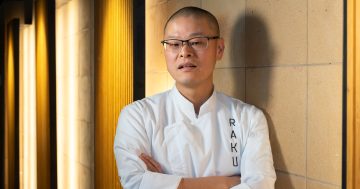
There’s nothing more Aussie than a BBQ, right? Photo: Michelle Kroll.
One of my colleagues asked me a tricky question this week: what is ‘Australian’ cuisine? It’s one that comes up semi-regularly for a (former) chef and (current) food writer, especially when I travel overseas. But it’s one I’ve always struggled to answer.
Of course, the first answer comes from the first peoples: Indigenous Australians have had a rich and diverse cuisine that modern Australia is only now coming to understand more fully. However, native foods – while they are gaining popularity in the broader food scene – are not the full picture of modern Australian cuisine.
Once upon a time, you might have said that a meat pie or fish and chips are Aussie dishes. But these are both colonial imports, and neither are particularly unique to Australia. Versions of barbecue are found all over the world too, and even pavlova was actually invented in New Zealand. Vegemite might qualify but one yeasty spread does not a cuisine make, no matter how thick you spread it.
The idea of a cuisine is a complex one. Many ‘iconic’ dishes would have once been totally out of place in the country where we expect them to belong. The tomatoes we consider so integral to Italian food were only introduced in the 16th century, tempura was likely brought to Japan by Portuguese Catholic Missionaries, and fortune cookies were invented in San Francisco. National cuisines and dishes are changing all the time.
It’s fair to say that the way Australians eat has also changed dramatically in the last 50 years. Different waves of immigration have introduced ingredients, techniques, and cultures that have gradually entered the mainstream. Before Italian and Greek migrants popularised it, olive oil was considered a medical product: your nan probably remembers having to buy it at the chemist! But these days, there would be a bottle of olive oil in most household pantries.
I was recently eating sushi with a friend, who remarked that while she didn’t eat any Japanese food until she was a teenager, her toddler finds it unremarkable to eat dishes from all over the world! We now have incredible access to foods and flavours in ways we didn’t in the past.

Tempura is considered a Japanese dish, but is the result of global influence. Photo: Thomas Lucraft.
As a teenager in my gap year, I travelled with friends in Italy and France, two countries whose cuisines I had been obsessed with for many years. After a couple of months, we ended up in a Parisian apartment on a street with a boulangerie, fromagerie and a picture-book-perfect French cafe. It was the archetypal Parisian dream.
But just down the road, there was a noodle restaurant, and I have never been so glad to see a plate of pad Thai in my life! We ate those takeaway noodles more than once until we were ready to dive back into what French cuisine had to offer. Even though I love, love, love Italian food and French fromageries, I missed the variety in my diet. We are spoiled for choice in beautiful, multicultural Australia – and we need to celebrate that diversity more.
While award-winning, fine-dining chefs – who are still disproportionately white in an industry that is hugely diverse – are free to appropriate ingredients to season their dishes, chefs of colour struggle to gain approval and legitimacy in the cliquey world of fine dining and chefs hats. Why do people insist an ‘authentic’ banh mi must cost less than $10 when they’re perfectly happy to pay $15 or more for a bourgie New York deli-style sandwich?
You may be thinking that fine dining isn’t necessarily indicative of what ‘everyday Aussies’ eat, but food is a form of fashion, and much like that infamous cerulean sweater (The Devil Wears Prada. It’s iconic, look it up), dishes that start in the world of food fashion houses eventually make their way to the everyday.
To return to the beginning, Australian chefs, cooks, and households should learn more about native ingredients. Traditional Indigenous foods are nutritionally dense and adapted to our climate, and many are incredibly delicious. But in doing so, we should also ensure that the profits go to Indigenous people rather than white-owned businesses jumping on the trend.

The Asian Bolognaise was a signature dish at XO and an example of cross-cultural cuisine. Photo: Lucy Ridge.
So where does that leave us? What is Australian food?
When asked that complicated question, I simply explain that modern Australian food is a cross-cultural cuisine, relying on European techniques to cook ingredients from a wide range of countries. Chefs can draw inspiration from all over the world when designing their menus, whether reimagining family recipes, recreating meals from travels, or reinterpreting classic dishes with a twist.
A history of colonialism, immigration and multiculturalism has left an indelible – yet very edible – mark on our broad cultural cuisine.





















